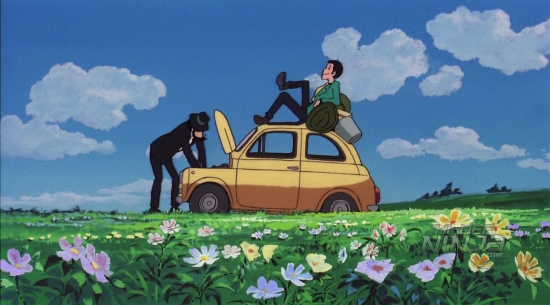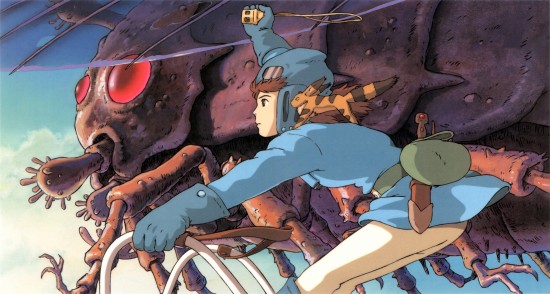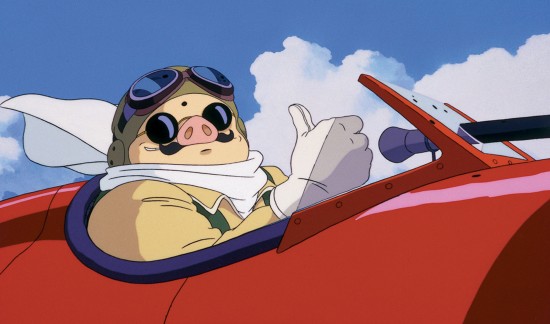Ranking The Films Of Hayao Miyazaki: The Master's Journey From 'Lupin III' To 'The Wind Rises'
We may receive a commission on purchases made from links.
Rumors of the closure of Studio Ghibli are not true, but it seems that Spirited Away and My Neighbor Totoro director Hayao Miyazaki may be done with feature filmmaking for good. In a career that spanned over thirty years directing features, Miyazaki refined his own storytelling and helped change the world's idea of what stories animated films can bring to audiences of all ages. And yet even with the muscle of Disney behind them, the films of Hayao Miyazaki have been somewhat slow to hit DVD and then Blu-ray in the US. (For Blu-ray that is in part thanks to a measured release plan in Japan.)
With the recent US Blu upgrades for Kiki's Delivery Service and Princess Mononoke, and the debut release of The Wind Rises on Disney home video, all but three of Miyazaki's films are now on blu-ray in the States. (Disney will probably have Spirited Away out by Christmas 2015.) That's as good a reason as any to look back at the filmmaker's illustrious career. There aren't any films on his CV you should not see — he has not made a bad movie — but below we'll look at the films of Hayao Miyazaki in ranked order, to help you figure out what to prioritize, in the event you're relatively new to his work.
Update: Disney has now also released Porco Rosso on blu-ray, along with excellent discs of Pom Poko and Tales From Earthsea. Disney's blu releases of Miyazaki (and Ghibli films in general) have been excellent, and stand as essential upgrades from previous releases. 11. Lupin III: The Castle of Cagliostro (1979)
11. Lupin III: The Castle of Cagliostro (1979)
Scripted by Hayao Miyazaki & Haruya Yamazaki based on the manga by Monkey Punch and novels by Maurice Leblanc.
Miyazaki's first efforts as director were for television, and his work on the Lupin III TV series — adapted from Monkey Pyunch's manga about the adventures of the world's foremost thief — laid the groundwork for this debut long-form story. The Castle of Cagliostro echoes the Pink Panther and James Bond movies, and prefigures Soderbergh's Ocean's films. It is a gleefully over the top vision caper movie with action and violence in the spirit of Looney Tunes cartoons, and which awkwardly but charmingly blends the ridiculous and mundane. Perhaps because Miyazaki was working with a well-known character set, he doesn't belabor the film with exposition, and Cagliostro is as breezy and entertaining as it is goofy and ridiculous. (New DVD release arrives in December with the Blu to follow shortly.)
 10. Howl's Moving Castle (2004)
10. Howl's Moving Castle (2004)
Scripted by Hayao Miyazaki based on the novel by Diana Wynne Jones.
The sumptuous animation of this odd fairy tale is not well matched by a script that often feels as if it is being spontaneously written as the film unfolds. With strong echoes of its vastly superior predecessor, Spirited Away, the story follows a cursed young woman who falls into the conflict between a tantrum-prone wizard and the government that demands his cooperation with an escalating war effort. A sense that Miyazaki is safely returning to tried and true material pervades as glimmers of several prior films shine through the thin story. Some truly excellent characters and ideas meander through Howl's Moving Castle, but the third-act resolution is the closest the director has come to self-parody.
 9. Nausicaä of the Valley of the Wind (1984)
9. Nausicaä of the Valley of the Wind (1984)
Scripted by Hayao Miyazaki
Visually, this is Miyazaki's first feature that is truly recognizable as his own, which makes sense given that it is an adaptation of his manga of the same name, and also an ambitious sci-fi fantasy to stand alongside the best visual flights of imagination from the '70s and '80s. It is also clearly an early work, lacking the quiet sophistication of Miyazaki's best filmmaking and reliant upon excessive expository dialogue and well-worn fantasy tropes. Still, Nausicaä is a more impressive achievement than most would-be fantasists manage even at the peak of their powers, and its heroine is an early indicator of the director's ability to create fantastic female characters. I'd almost say I'd love to see Miyazaki remake this early work, but that's what Princess Mononoke is for. This is a promising indication of what was to come, but also perhaps most likely to be appreciated by fans of classic anime storytelling and those seeking the early stages of Miyazaki's development.
 8. Ponyo (2008)
8. Ponyo (2008)
Scripted by Hayao Miyazaki loosely inspired by The Little Mermaid by Hans Christian Anderson.
The simplicity of this story is matched by some of the most endearing character designs of Miyazaki's career, as a young boy discovers a goldfish with ambitions to be a human girl. Underwater, however, is where the film truly glows, as the designs and animation of innumerable sea creatures are the hidden jewels nestled within Ponyo. This is among the most simple stories in the director's career, and one of the more under the radar family movies to debut in quite a while, but simplicity doesn't mean that Ponyo is rote or underdeveloped — there is a genuine sweetness here, and a wide-eyed approach to the world that is as refreshing as time spent wading through gentle tidal pools.
 7. Kiki's Delivery Service (1989)
7. Kiki's Delivery Service (1989)
Scripted by Hayao Miyazaki.
The recent blu-ray release of this film is one of the things that spurred this list, and it is a treat to see this cheerfully optimistic coming of age story finally presented in the best version we've seen in the US. Kiki's has a softly episodic approach to storytelling as we follow the eponymous young witch who, in accordance with custom, chooses a new home town and begins to develop not just her magic, but her personal character and place within the community. The supernatural trappings are really just an arch metaphor that allows Miyazaki to playfully envision a young girl's first steps towards true adulthood and independence. (Kiki's ability to fly — and her trouble staying in the air — also provide an opportunity for an unlikely action setpiece that is contrived and yet fully able to win over even the coldest audience.) Compared to his best films Kiki's feels a bit under-developed, but plays like a zephyr of a pop song that brightens the day. Its big-hearted spirit is impossible to deny.
 6. Porco Rosso (1992)
6. Porco Rosso (1992)
Scripted by Hayao Miyazaki.
This is perhaps the strangest film in Miyazaki's oeuvre, as it riffs on Casablanca and wartime adventure movies while blending his interest in flight, world history, magic, and comedy. In the years after WWI, one of the greatest wartime pilots has been cursed to live in the form of a pig; the shape suits his demeanor and somehow does not impede his ability to pilot a plane. Yet its young heroine, a budding aircraft engineer, emerges as the true star of the film. Porco Rosso is the last feature Miyazaki directed before taking a five-year break. It effectively marks the end of the first half of his career, with sky pirate characters that echo the antagonists from Castle in the Sky and an overall sense of design that would be streamlined in future films. It prefigures The Wind Rises not only with an interest in aircraft, but in the exploration of the intersection between flight and warfare. Porco Rosso is an awkward film, but one in which Miyazaki's love for every new facet is warmly obvious.
 5. Princess Mononoke (1997)
5. Princess Mononoke (1997)
Scripted by Hayao Miyazaki.
Looking at Miyazaki's work as a whole, many of his films seem to fall into paired groups. There's Porco Rosso and The Wind Rises; Spirited Away and Howl's Moving Castle; and Nausicaä and Princess Mononoke. Shedding the science fiction elements of Nausicaa, here Miyazaki pulls the conflict between man and nature into sharp focus. Violent in a way that is rare for the director, this story of the prince of a lost tribe who seeks knowledge in the Western lands once occupied by his people sets up conflict between multiple animal and human societies, but never loses focus on its grand vision of the impact human expansion and presumption has on the world around us. The film's titular heroine emerges slowly, but her feral and uncompromising nature makes her unique not only in Miyazaki's work, but in cinema as a whole.
 4. Castle in the Sky (1986)
4. Castle in the Sky (1986)
Scripted by Hayao Miyazaki.
Miyazaki's second film (and the first Studio Ghibli production) is an energetic, inventive and gorgeous effort that demonstrates a significant leap forward in cinematic technique, and an equal increase in storytelling confidence. The story of a young boy and girl who follow clues in their family history to the discovery of an ancient technology is like a fusion of the best impulses of early- and mid-'80s adventures from Amblin and Lucasfilm. Miyazaki trades in wonder but often avoids indulging in deep naivety and sentimentality. The somewhat unrefined sense of character design and script structure are charming more often than not. While a more elegant development of the story would probably help this play better for younger kids, the grand third act of Castle in the Sky can deservedly be called epic, with a perceptible influence on The Iron Giant.
 3. The Wind Rises (2013)
3. The Wind Rises (2013)
Scripted by Hayao Miyazaki based on his manga Kaze Tachinu.
Miyazaki's final feature is a reflection upon not only one of his great preoccupations — flight, and the machines that allow humans to take to the air — but also a consideration of the ethical complications of those machines. Jiro, a quietly brilliant young aircraft engineer dreams of his ideal airplane design, and finds work at Mitsubishi, where he applies himself to several projects while refining his own concepts. The Great Kanto Earthquake of 1923 effectively opens the film, and is one of the most impressive sequences in any of Miyazaki's work. The devastating result of that natural disaster is also echoed in Jiro's nightmare of a post-war landscape following the culmination of his greatest aircraft design, which is among the film's many subtle methods of engaging the morally difficult implications of Jiro's engineering ambitions. The romance that shades the film's final third is a fine concept through which to explore the film's idea of the pursuit of dreams and the difficult process of reconciling pure desire with harsh realities. It is also, unfortunately, a pale addition to the story as a whole, which saps the film's energy.
I'll offer a heretical recommendation: watch The Wind Rises in its English dub. The Japanese voice actor for Jiro, Hideaki Anno (primarily a writer and director of anime) isn't the greatest performer, and in the English voice track Joseph Gordon-Levitt does an outstanding job with the role. That English dub track maintains the quirky and unusual sound effects for aircraft and the earthquake, which use human-voiced sounds such as breaths and exhalations to pitch the film's landscape somewhere between imagination and reality.
 2. My Neighbor Totoro (1988)
2. My Neighbor Totoro (1988)
Scripted by Hayao Miyazaki.
Miyazaki's fourth feature is his first attempt to explore the intersection between a the landscape of dream and folklore with a world that could be our own. It is also a quietly magnificent family story in which two young girls are given center stage as they learn the landscape around their new family home, with the shadow of a difficult situation hanging over them. The pitch-perfect characterization of the girls is matched by the depiction of a set of cute but somewhat inscrutable forest spirits that inhabit nearby woods. Two of the film's creations — the Totoro spirit, and the wonderfully odd Catbus that transports it from one forest to another — are as close to perfect icons for Miyazaki's own creative spirit as any artist could hope to achieve.
 1. Spirited Away (2001)
1. Spirited Away (2001)
Scripted by Hayao Miyazaki.
This ultimate example of Miyazaki's art is a jawdropping spectacle in which a young girl comes of age whilst trapped in a fairy land populated by spirits from Japanese folk tales. This synthesis of ideas old and new roots Miyazaki's common interests — flight, young heroines, magical transformations — in a story concept rooted in dreams and tradition. Vividly visualized but never beholden only to spectacle, Spirited Away is own of the crown jewels of hand-drawn animation, even with its light use of computer-assisted embellishments. This is a film in which every movement reveals and reinforces character, and in which Miyazaki's confidence as a storyteller truly steals the show. Simply watching the animated characters cross a bridge is a joy, and as the young girl Chihiro explores a bathhouse for weary fairy spirits Miyazaki and his animation team have the opportunity to create dozens of gloriously rendered characters . Spirited Away takes audiences to places we've never been, but which still feel strangely familiar.
